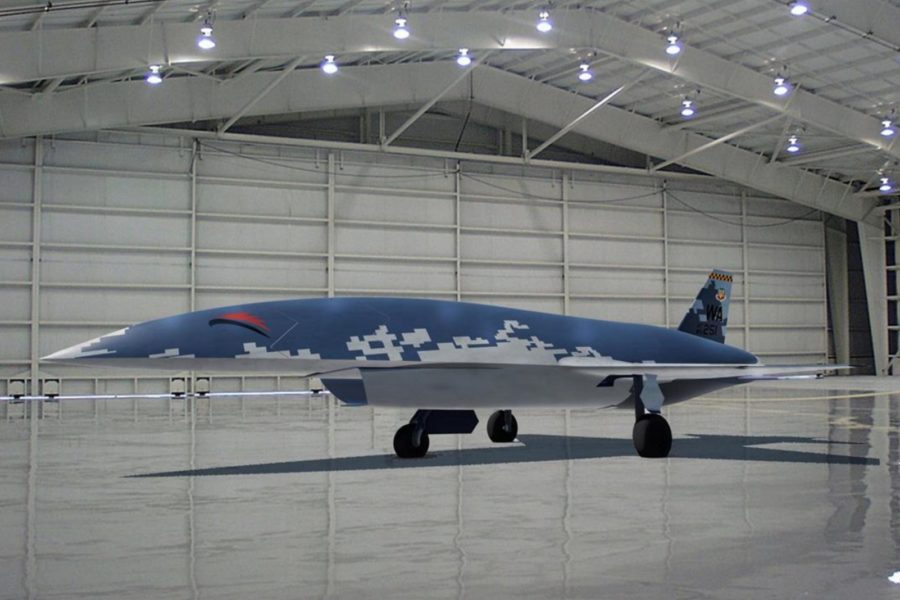Blue Force Technologies expects a contract in the next month authorizing it to proceed with development of a stealthy, unmanned aerial system for Air Force fifth-generation fighters to train against. The company expects to build four aircraft for a demonstration program, with first flight in July 2023.
The aircraft are being developed using small business development money under the Air Force Research Laboratory and Air Combat Command.
ACC boss Gen. Mark D. Kelly touted the program during the recent Air Force Lifecycle Management Center’s Life Cycle Industry Days conference as the Air Force’s first “toe in the water” trying out low-cost, attritable aircraft technologies. He sees the technologies as an affordable way to put up enough stealthy, maneuvering, fighter-like aircraft to really stress USAF’s fifth-generation F-22 and F-35 fighters in training. He said the program could yield aircraft that provide high-level adversary training at only 25 percent of the cost of manned systems.
“That, to me, is low cost,” Kelly said.
The company, which has experience fabricating vehicles and structures for other firms, anticipates a cost per flying hour of about $4,000, versus $50,000 per hour for an F-22.
With a 5,000-pound max takeoff weight, the aircraft—known for now as “Red Medium”—will have modular payloads and open-systems architecture, allowing a wide array of threats to be simulated, the company’s founder and president Scott Bledsoe said. It will use a Williams FJ44-4 engine, a 4,000-pound thrust class “military trainer derivative of their biggest business jet engine,” he said. The 20-foot-long, 17-foot-span, carbon-fiber jet will be capable of attaining Mach .95 and turning at up to 9Gs, with a 4G sustained turn. It will also have persistence to fly two adversary engagements without landing to refuel.
“We can produce a high subsonic-class threat,” Bledoe said.
The company has already passed through preliminary design review and would enter critical design review in June 2022, assuming a next-phase contract in the next month. Bledsoe said the project has been nurtured by AFRL and AFWERX and that AFRL has even allowed the company to use some of its high-speed computer capability for design work.
Under an earlier contract phase that concluded last month, Blue Force demonstrated that “we have an aircraft design that’s stable, controllable, meets performance requirements, and meets cost requirements,” Bledsoe said. The company is ready to “go start cutting tooling and building it.”
The concept arose in 2016. While many small UAS companies were looking to meet Air Force intelligence, surveillance, and reconnaissance needs, the service was not yet ready to create a program of record. However, “Adversary air is a kind of wide-open field, nobody has a good answer, and the Air Force has this looming problem,” Bledsoe said. The company talked to fighter pilots about what they needed in an adversary system, collaborated with ACC, and launched the project. Creative use of USAF small business money, such as AFVentures’ Strategic Finance program, government matches, and other initiatives to draw in small business players made the project affordable and manageable, Bledsoe said.
Hermeus, another company getting Strategic Financing program funding, received a contract this week to develop hypersonic vehicles.
Blue Force Technologies has built a ground test model, completed last month, to verify and integrate systems with a ground control station, which will allow “burning down as much systems integration risk as possible,” Bledsoe noted. This has led to more ACC endorsements.
The jet will have an “open architecture” nose to allow reconfigurable threats that will appear to Air Force jet sensors like adversary aircraft. In fact, standards have been published, and the system is so open that “a third party can integrate the nose of the aircraft without even calling us,” Bledsoe said. “We were really first in the industry to take that approach.”
This was done because the Air Force may want to use the aircraft for something other than adversary work—it will be low observable—and in case “it needs to go places and do things that we don’t necessarily need to know about,” Bledsoe said.
Andrew Van Timmeren, a former F-22 pilot who is an adviser to Blue Force Technologies on adversary air, said the new aircraft will offer an opportunity for fighter pilots to get comfortable operating with an unmanned aircraft.
“We are 100 percent focused on designing and building an adversary replication platform,” Von Timmeren said. But “that doesn’t mean it’s not going to collaborate with the other Red Air players … trying to punish Blue Air mistakes. … If we can pretend to be adversaries pretty good, I think we can pretend to be the blue guys pretty good.”
“As a Raptor guy,” he explained, “I need to practice” manned/unmanned teaming in a non-lethal environment before going to war with such a system. Fighter pilots need to be able to trust an unmanned system not to “crash into me or crash into the ground.” Without that trust, “I’m actually going to ask you to just leave it at home—I don’t want it to go to war with me.” Right now, ISR systems don’t typically collaborate with fighters.
But “this thing is going to roll around in the mud with me and my bros, my friends who are still flying, and if we can continue to develop that and develop data for future autonomous vehicle development,” that trust will be developed.
As an adversary, the jet will do the mission at low cost more effectively than any other way, he said.
“You can’t go to the boneyard to find something that’s relevant” to modern combat “versus being clean-sheet designed; that’s purpose-built,” Von Timmeran said. “This is going to cost less because it’s essentially all ‘commercial, off-the-shelf.’ ”
The company’s concept anticipates two of the aircraft being transportable in a single box, similar to the way MQ-1 Predator drones were transported.
Blue Force is also looking at putting hardpoints on or in the aircraft if the Air Force should want an offensive version, the company said.
